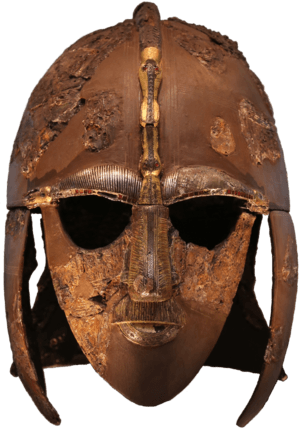Sutton Hoo Helmet (sculpture) facts for kids
The Sutton Hoo Helmet is a large sculpture made in 2002. It was created by an English artist named Rick Kirby. This sculpture looks like the famous Sutton Hoo helmet. That original helmet was found in an ancient ship-burial site called Sutton Hoo.
The National Trust asked Rick Kirby to make this sculpture. They wanted it to hang outside their visitor centre at Sutton Hoo. A famous writer, Seamus Heaney, helped to show the sculpture to the public on March 13, 2002. It stayed at the exhibition hall entrance until 2019. Now, you can see it at the main entrance to the Sutton Hoo site.
This impressive sculpture is about 1.8 meters (6 feet) tall. It is 1.2 meters (4 feet) wide and 1.6 meters (5 feet) deep. It weighs a huge 900 kilograms (almost 2,000 pounds)! The sculpture is made from red-coloured steel plates. It was designed to look "fierce" and powerful. It shows how the real helmet looked after being put back together from many pieces.
Contents
What is the Sutton Hoo Helmet Sculpture?
The Sutton Hoo Helmet sculpture is a giant version of a very old helmet. This helmet was found in a special burial site. The artist, Rick Kirby, made it from many pieces of steel. This makes it look like the original helmet, which was found in many fragments.
How Big is the Sculpture?
The sculpture is much bigger than the real helmet. It stands about 1.8 meters (6 feet) tall. It is 1.2 meters (4 feet) wide. The sculpture is 1.6 meters (5 feet) deep. It weighs about 900 kilograms (2,000 pounds). The actual helmet is much smaller, only about 31.8 centimeters (12.5 inches) tall.
What is the Sculpture Made Of?
The sculpture is made from mild steel plates. These plates are coloured red. Rick Kirby often uses steel in his art. He likes how it lets him create very large and dramatic pieces. The sculpture's mask-like look is also something he uses in other artworks.
The Story Behind the Sculpture
The Sutton Hoo Helmet sculpture has an interesting history. It connects to an amazing discovery made in England.
The Sutton Hoo Discovery
In 1939, archaeologists found an incredible Anglo-Saxon grave. It was located near the River Deben in Woodbridge, Suffolk. This Sutton Hoo ship-burial was incredibly rich. People even called it "Britain's Tutankhamun".
The finds from Sutton Hoo changed how we see the "Dark Ages". We now know this time was full of wealth and advanced skills. It became known as the Middle Ages. The most famous item found was the Sutton Hoo helmet. It was carefully put together from over 500 small pieces. Over the years, this helmet has become a symbol of the Middle Ages. It also represents archaeology and England itself.
Building the Visitor Centre
The Sutton Hoo treasures were given to the British Museum. The land where they were found was privately owned until 1998. Then, the land and a house called Tranmer House were given to the National Trust.
In 2000, the National Trust decided to build a visitor centre. This centre would help people learn about Sutton Hoo. It cost about £5 million to build. The famous writer Seamus Heaney opened the centre on March 13, 2002. He had translated Beowulf, an old Anglo-Saxon poem. This poem describes burials similar to the one at Sutton Hoo.
How the Sculpture Was Made
The National Trust asked Rick Kirby to create a special artwork for the new visitor centre. They wanted something with a "fierce presence." Rick Kirby had already made several public sculptures. One was outside St Thomas' Hospital and another in Calne.
The Sutton Hoo Helmet sculpture was lifted into place on February 26, 2002. It was put above the entrance of the exhibition hall. It stayed there until 2019. On May 30, 2019, it was moved to its current spot at the site's main entrance.

Before making the big sculpture, Kirby made a smaller model. This model is called a maquette. In 2005, this maquette was offered for sale by an art gallery.
Images for kids




